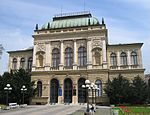Slovenian Museum of Natural History

The Slovenian Museum of Natural History (Slovene: Prirodoslovni muzej Slovenije, Latin: Museum Historiae Naturalis Sloveniae) is a Slovenian national museum with natural history, scientific, and educational contents. It is the oldest cultural and scientific Slovenian institution. The museum features national, European, and worldwide collections demonstrating the changes in biodiversity, the development of the natural history thought, as well as different techniques of collection and preparation of samples. Its research activities focus on natural heritage of Slovenia. The Slovenian Museum of Natural History operates in the Center District in Ljubljana, the capital of Slovenia, at Museum Street (Muzejska ulica), near Tivoli Park, the Parliament and the Opera House. Along with the National Museum of Slovenia, it is housed in a building from 1885, built upon the plans by the Viennese architect Wilhelm Rezori and the master builder Wilhelm Treo from Ljubljana. The symbol of the museum is an almost complete woolly mammoth skeleton, found in Nevlje near Kamnik in 1938. Its official publication, published since autumn 1978, has been named Scopolia in honour of Giovanni Antonio Scopoli, a leading Carniolan naturalist of the 18th century.
Excerpt from the Wikipedia article Slovenian Museum of Natural History (License: CC BY-SA 3.0, Authors, Images).Slovenian Museum of Natural History
Prešernova cesta, Ljubljana Rožna dolina
Geographical coordinates (GPS) Address Website Nearby Places Show on map
Geographical coordinates (GPS)
| Latitude | Longitude |
|---|---|
| N 46.052222222222 ° | E 14.499444444444 ° |
Address
Narodni muzej Slovenije – Prešernova
Prešernova cesta 20
1000 Ljubljana, Rožna dolina
Slovenia
Open on Google Maps






